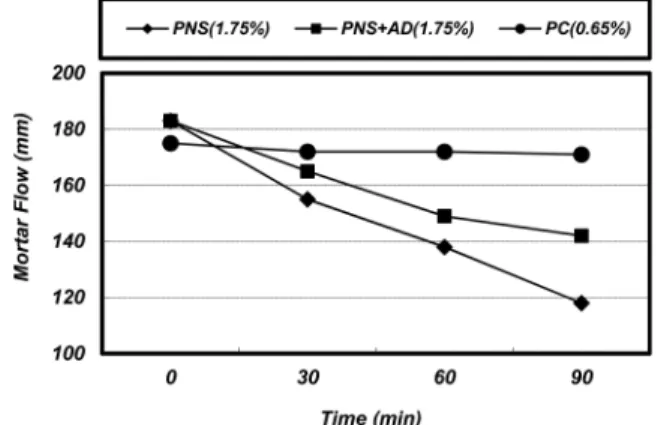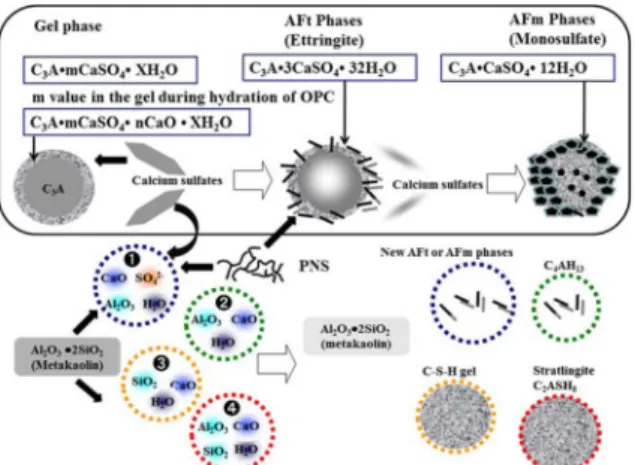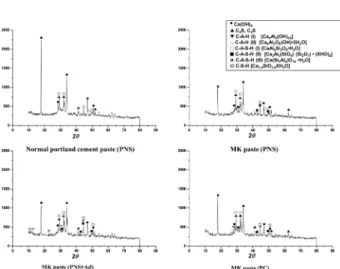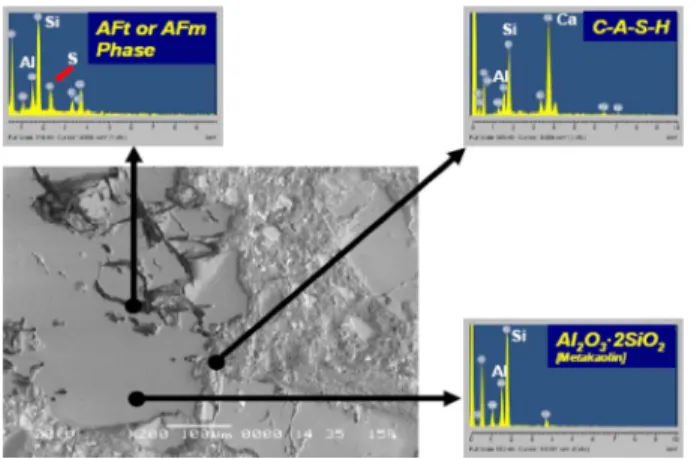181
Ceramic
Processing Research
The relationship between various superplasticizers and hydration of mortar
incorporating metakaolin
Tae-Ho Ahna , Kwang-Bo Shimb and Jae-Suk Ryoub,*
aInnovative Construction Materials Engineering, Institute of Industrial Science, The University of Tokyo, 4-6-1 Komaba,
Meguro-ku, Tokyo 153-8505, Japan
bInternational Sustainable Engineering Materials (ISEM) Center, Ceramic Materials Institute, Hanyang University, 222
Wangsimni-ro, Seongdong-gu, Seoul 133-791 Korea
cDepartment of Civil Engineering, Hanyang University, 222 Wangsimni-ro, Seongdong-gu, Seoul 133-791, Korea
Three different superplasiczers such as PNS (poly naphthalene sulfonate), PNS with additive (copolymer of acrylic acid, acrylic ester and maleic acid), and PC (polycarboxylate) were used to investigate the effect of superplasticizer types on the properties of mortar incorporating metakaolin (MK). When MK was hydrated, diffusion behaviors of aluminate and silicate were examined separately at 1, 3, 7 and 28 days by X-ray diffraction, SEM/EDS and for considerable effect on the hydration rate and hydrates types. The results showed that PNS with additive were effective in promoting pozzolanic reaction. Considering the workability and the compressive strength, it is desirable to use PNS with additive in the production of high-performance concrete incorporating MK.
Key words: PNS, superplasticizers, Metakaolin, Compressive strength, High-performance concrete.
Introduction
The construction industry has made great strides especially in the construction material field over the past two or three decades. Among construction materials, pozzolanic materials such as silica fume, fly ash, slag and natural pozzolans have played an important role in improving the quality of concrete products in compressive strength and durability. This is due to the fact that the calcium hydroxide produced by the cement hydration reacts with the pozzolan and produces and additional gel which has a pore blocking effect, and therefore alters the pore structure and the strength [1]. In addition of MK in concrete and mortar can improve to become dense ITZ(Interfacial Transition Zone) and pore structure in concrete and mortar optimized and pore size distribution is more reasonable. Therefore, the MK can improve microstructure as well as compressive strength [2]. The use of MK is reduced with the increase of the sodium hydroxide concentration, because MK has a high Blaine fineness [3]. Moreover, reduction of calcium hydroxide (CH) leads to improved resistance against sulfate attack [4, 5]. In addition, incorporation of MK can increase resistance to acids and sulphates, reduce porosity, reduce oxygen permeability, reduce chloride ion diffusivity, prevent or minimize the risk of alkali-silica reaction and reduce the unsightly effect of
efflorescence [6, 7, 8]. MK is already reported as showing similar properties with silica fume (SF) in cement hydration behavior and development of compressive strength [9, 10]. Many researchers have established the theoretical and practical basis for the use of MK in concrete. However, most of them still focused on the development of its compressive strength [14] and durability [15]. Therefore, MK concrete is still not fully investigated yet about the interaction between MK hydration and various superplasticizers. The aim of this study is to investigate hydration behavior of MK cement paste on mortar according to various superplasticizers. In addition. In order to understand the influence of superplasticizers type on the hydration of cement paste incorporation MK, XRD, and SEM/EDS analysis were also performed.
Experimental Program
Materials
Type 1 normal portland cement, MK and SF were used as binding materials. Both the normal portland cement and MK are commercial products manufactured in Korea. The color of MK manufactured in Korea is light pink because of its relatively high content of Fe2O3 while the color of MK manufactured in other countries is nearly white.
Superplasticizers
Three different types of commercially available superplasticizers such as PNS, PNS + AD (PNS with
*Corresponding author: Tel : +82-02-2220-4323 E-mail: jsryou@hanyang.ac.kr
additive) and a PC (polycarboxylate) type superplasticizer were used in order to investigate the effect of each superplasticizers on the fluidity and the compressive strength of MK mortar. Solid content of all su-perplasticizers was 40%. PNS + AD were prepared by mixing PNS with additive (copolymer of acrylic acid, acrylic ester and maleic acid), respectively. Chemical structure of each superplasticizer is shown in Fig. 1 Experimental Method
Table 1 shows the mixture proportion of mortar test. All mortars having a 0.40 W/B (B : Binder) and 2.14 S/B were tested. MK was used to replace normal portland cement by 10 wt%. Dosage of each superplasticizer was in the range of 0.65 ~ 1.75% to obtain the target initial fluidity (170 ~ 180 mm) of mortar. Mortar flow was measured up to 90 minutes, at time interval of 30 minutes. Mortar cubes were prepared according to the ASTM C 109 test method and the compressive strength was measured at 1, 3, 7 and 28 days.
XRD and SEM/EDS Analysis
The XRD analysis was carried out to investigate the effect of superplasticizer type on the hydration behavior of MK pastes. All pastes having 0.40 W/B were treated with acetone after 1, 3, 7 and 28 days to prevent further hydration and ground in order to analyze their XRD pattern. The superplasticizers were used to obtain the initial mini-slump flow(diameter of cement paste) in the range of 130 to 140 mm. All mortar specimens for SEM/EDS were cast at room temperature and cured for 24 h at 20oC in a moist curing room. After demolding, the specimens for SEM/ EDS were examined at different ages in order to clarify the hydration behavior of MK.
Results and Discussions
Effect of superplasticizer types on the fluidity and compressive strength of the MK mortar
The effectiveness of different types of superplasticizers on the fluidity and compressive strength of MK mortar was investigated in order to find reasonable superplasticizers for MK. In this study, three different superplasticizers such as PNS, PNS + AD and PC were used. As shown in Fig. 2, the effect of the superplasticizer type on the fluidity retention was considerably different, even though all the MK mortars had a similar initial fluidity by the addition of 1.75% of PNS, 1.75% of the PNS + AD and 0.65% of PC, respectively. PC appeared to be most effective in retaining the fluidity followed by the PNS + AD and PNS. Although PC showed excellent performance in fluidity retention, but it exhibited poor performance in the development of compressive strength. Because side effects of bleeding or a strong retardation occurred, as shown in Fig. 3.
As shown in Fig. 3, PC appeared to retard the hydration of MK mortar compared to PNS and the PNS + AD. In contrast, the PNS + AD seemed to accelerate the hydration of the MK mortar compared to the other superplasticizers.
W/B B S W SP
40% 900 g 1926 g 360 g 0.65-1.75%
*Binder(B): When MK was used, 10% of normal portland cement was replaced with MK or SF.
*Liquid type superplasticizers (solid content 40%) were used.
Fig. 3. Effect of superplasticizer type on the compressive strength of MK mortar.
Behavior of hydration on MK cement system incorporating superplasicizers
Generally, the addition of PNS or PMS (Poly Melamine Sulfonate) increases the negative zeta potential on the cement particles, causing larger electrostatic repulsive forces between cement particles, thus main-taining fluidity [15].However, in the case of cement mixed with MK, it seems to adsorb PNS or PMS faster than other mineral admixtures [10], because MK has relatively fine particles containing soluble silicate and aluminate. So the formation of C-A-H, C-A-S-H, AFt and AFm phases are faster than other cementitious minerals, therefore flow loss is relatively high. On the other hand, in the MK cement containing PC, a smaller amount of PC molecules seems to be adsorbed because the functional groups in a PC structure have less affinity to AFt and AFm phases [15, 16, 17]. However, it didn’t show good performance in terms of compressive strength. Thus, in case of PNS + AD (PNS based blends [modified PC]), it showed the reasonable performance for the flow retention effect compared to other superplasticizers without loss of compressive strength in the early stage. Therefore, considering both the fluidity and the compressive strength of MK mortar, it can be concluded that based on the limited tests, when MK is used for the purpose of manufacturing high-performance concrete, it is desirable to use the PNS + AD rather than the PNS and PC. Furthermore, MK seems to adsorb sulfate ions from CaSO4 •XH2O in the cement with the same time. This is also very important role on the fluidity loss at the initial stage of MK cement system. First, in case of cement system, C3A/SO3 ratio in C3A gel phases can be affected the formation of AFt and AFm phases as shown in Fig. 4 [18]. The Hydration ratio of C3A in Ca3Al2O6-calcium sulfates gel phase [C3A•mCaSO4 • XH2O] system depends on the m value of gel phases. Namely, if m value in gel phase is low, the hydration ratio of C3A abruptly increases in order to formation of AFt or AFm phases. In other words, when MK added at initial stage as mentioned above, it also seems to
adsorb lots of sulfate ions from CaSO4 •XH2O with PNS, thus, it seems to accelerate the hydration of C3A in order to compensate m value in the C3A gel phases. Therefore, fluidity can be decreased rapidly compare to normal portland cement case with added PNS. Secondly, in case of MK on the cement system, dissolved Al3+, Si2+ ions from MK and Ca2+ ions from C3S and C2S seems to be formed newly AFt, AFm, CAH and C-A-S-Fig. 4. Behavior of hydration on cement paste incorporating MK.
Fig. 5. XRD Patterns of each paste sample at 1 day.
Fig. 6. XRD Patterns of each paste sample at 3 days.
H gel with sulfate ions from PNS and CaSO4 •XH2O.
Finally, both cases will be affected compressive strength as well as fluidity in the MK cement system. It was
reported that hydration heat curve of C3S was
accelerated compare to normal portland cement case at initial stage when MK added in the cement [11]. This also means that it can be led to increase compress strength at initial stage. Furthermore, it has a lot of relationship between consumption of CH by pozzolanic reaction and its acceleration by superplasticizers [1, 12]. Thus, if it can be controlled formation of AFt, AFm, and C-A-S-H phases by other superplasticzers which have good compatibility with AFt or AFm phases, it seems to be overcome this problem at early stage. Hydration mechanism of MK mortar containing various superplasticizers
As described above, MK will be affected by various superplasticizers. Therefore, to clarify these mechanisms,
except a Ca(OH)2 peak appeared and small quantities of
CSH and CAH([Ca3Al2(OH)12]) were produced. There
was no distinct difference in the hydration between MK paste including PNS and MK paste including PNS + AD. However, in case of MK paste including PNS + AD, there appeared two types of CAH such as [Ca3Al2(OH)12]
(type I CAH) and [Ca6Al2O6(OH)•2H2O](type II CAH)
as well as CSH. Type II CAH, which seemed to be produced by a pozzolanic reaction, was not visible in the MK paste including PNS and MK paste including PC. Moreover, evidence of formation of AFt or AFm phases from MK was first detected in case of PNS + AD. X-ray spectra obtained from these phases revealed particular trends in their chemical composition as formation of AFt or AFm phases proceeded. It was observed that the ratio of sulfate peak height increased as shown in Fig. 9. Fig. 10 shows the morphology of MK mortar contacting PNS + AD at 1day. A lot of AFt phases were also formed in the pores and air voids. And it was found that MK particles between aggregates were reacted with cement pastes quickly compared to other specimens at the same time. At 3 days, two types of CASH such as [CaAl2Si2O8 •H2O](type I CASH) and Fig. 8. XRD patterns of each paste sample at 28 days.
Table 2. Main hydration products of each paste sample by XRD. Time
Sample 1 day 3 days 7 days 28 days
OPC (PNS) Ca(OH)2 C3S, C2S Ca(OH)2 C-A-H(I) Ca(OH)2 Ca(OH)2 C-S-H MK (PNS) Ca(OH)2 C3S, C2S Ca(OH)2 C-A-H(I) C-A-S-H(II) Ca(OH)2 C-A-H(I) C-A-S-H(II) Ca(OH)2 C-A-S-H(II) C-S-H MK (PNS + AD) Ca(OH)2 C-A-H(I) C-A-H(II) C3S, C2S Ca(OH)2 C-A-H(I) C-A-S-H(I) C-A-S-H(II) Ca(OH)2 C-A-S-H(I) C-A-S-H(II) C-A-S-H(II) Ca(OH)2 C-A-S-H(II) C-A-S-H(III) C-S-H MK (PC) Ca(OH)2 C-A-H(I) C3S, C2S Ca(OH)2 C-A-H(I) Ca(OH)2, C-A-S-H(II) Ca(OH)2 C-A-S-H(I) C-A-S-H(II) C-S-H C-A-H (I): 3CaO•Al2O3•6H2O.
C-A-H (II): Ca6Al2O6(OH )•2H2O.
C-A-S-H (I): CaO•Al2O3•2SiO2•XH2O.
C-A-S-H (II): 2 CaO•Al2O3•2SiO2•(Al•SiO2)•XH2O.
[Ca2Al3(SiO4) (Si2O7)•(XHO)2](type II CASH) appeared in the MK paste including PNS + AD. However, in the MK paste including PNS, type I CASH was not found at 3 days. Moreover, there was no CASH peak in MK paste including PC at 3 days. Fig. 11, 12 and 13 show the X-ray maps and spectra taken from reacted MK particles on each specimen at 3 days. Fig. 11 shows X-ray maps of the partially diffused MK particles from MK paste
including PNS, In addition, Fig. 12 shows accelerated diffusion of MK particles in case of PNS + AD compared to PNS and PC case. Evidence of various C-A-S-H phases according to Ca ion and Al ion was detected in this specimen. However, X-ray spectra taken from MK particles including PC shows also retarded diffusion on hydration as shown in Fig. 13. At 7 days, another different type of CASH([Ca(Si7Al2)O18 •H2O], type III) was produced at 7 days only in MK paste including PNS + AD, while type I CASH disappeared. These results seemed that type I CASH reacted with silicate to form type III CASH. It was also observed that, type II CASH began to appear in MK paste including PC. At 28 days, the main hydrates in MK paste including PNS + AD were CSH, type II CASH and type III CASH. However, type III CASH was not found in MK paste including PNS nor in MK paste including PC. There was a considerable amount of CAH in MK paste including PC, which means that the retardation effect of PC lasted up to 28 days. It has been reported that C2ASH8 and CSH gel are the most important hydrates in MK-lime system [19], however, the hydrates types and their stabilities with hydration time depend on the MK/lime ratio, temperature and the presence of different activators [20]. Hydration behavior and hydrates types in a MK-cement system is more complicated than those in a MK-lime system. Nevertheless, considering the complexity of a MK-Fig. 9. X-ray spectrum from MK mortar containing PNS + AD at
1day.
Fig. 10. Morphology of MK mortar containing PNS + AD at 1day (a) Formation of AFt phases within pores and air voids (b) hydration of MK particles between aggregates.
Fig. 11. X-ray spectrum from MK mortar containing PNS at 3 day.
Fig. 12. X-ray spectrum from MK mortar containing PNS + AD at 3 day.
cement system, it was found from XRD and SEM/EDS analysis that the superplasticizer type considerably affected the hydration rate and hydrates types [21]. Chemical interaction between MK and various superplasticizers
PNS + AD had two distinct effects on the MK paste; the acceleration of pozzolanic reactions and the formation of different types of hydrates, such as type II CAH, type III CASH and AFm, which were not formed in MK paste including PNS nor MK paste including PC at early stage. Therefore, considering the fact that type III CASH contains larger amount of Si than type I CASH and type II CASH, it can be said that PNS + AD seems to be effective in inducing the dissolution of MK. [AD will act as an accelerator for diffusion of MK] Fig. 14 shows a schematic summary of accelerated or retarded hydration of MK paste and
mortar depending on various superplasticizers. It can be concluded that PNS + AD increases the compressive strength of MK mortar after 3 days because of its acceleration of both dissolution of MK and pozzolanic reactions.
Finally, the CaO-Al2O3-SiO2-H2O system at ordinary
temperatures is modified by the addition of various superplasticizers to cement paste incorporating MK. Especially, CH reacted with Al or Si ions from MK at an early stage, and then it was decreased during curing. C-A-S-H[stratlingite] was also formed with hydrogarnet phases when hydration of MK was accelerated by accelerator as AD. Therefore, a phase diagram of cement incorporating MK could be predicted, as shown in Fig. 15 [22], and its phase boundary condition will be studied by thermodynamic calculation in future works.
Conclusions
1. The superplasticizer type significantly affected the fluidity and compressive strength of the MK mortar. PNS + AD are more desirable for the production of high-performance MK mortar because PNS + AD increase the compressive strength as well as improve the fluidity of MK mortar.
2. The addition of PNS-based superplasticizer blends to the MK blended cement improved the fluidity and early compressive strength, which is attributed to the formation of C-A-H and Stratling (C-A-S-H), AFt (including primary ettringite) and AFm phases. Especially, additives of PNS + AD acted as an accelerator for the diffusion of MK in the cement system.
3. The XRD and EDS/SEM analysis results revealed that the rate of pozzolanic reaction and hydrate types were largely dependent on the superplasticizer type. PNS + AD were efficient superplasticizers in accelerating pozzolanic reaction, which seemed to contribute considerably to the higher compressive strength of the MK mortar.
4. PNS + AD had two distinct effects on the MK paste; the acceleration of pozzolanic reactions and the formation of different types of hydrates, such as type II CAH, type III CASH and AFm, which were not formed Fig. 14. Interaction between MK and various superplasticizers.
in MK paste including PNS nor MK paste including PC at early stage. Therefore, considering the fact that type III CASH contains larger amount of Si than type I CASH and type II CASH, it can be said that PNS + AD seems to be effective in inducing the dissolution of MK.
Acknowledgments
The author would like to thank for the advice provided by SERIC. Co., Ltd. in Korea (www. seric. co.kr).
References
1. Wild S, Khatib JM. Portlandite consumption in metakalolin cement pastes and mortars, Cement and Concrete Research, 27 [1] (1997) 137-146.
2. Pacheco-Torgal F, Moura D, Ding Yining, Jalali Said. Composition, strength and workability of alkali-activated metakaolin based mortars, Construction and Building Materials, 25 (2011) 3732-3745.
3. Duan Ping, Shui Zhonghe, Chen Wei, Shen Chunhua. Effects of metakaolin, silica fume and slag on pore structure, interfacial transition zone and compressive strength of concrete, Construction and Building Materials, 44 (2013) 1-6.
4. Al-Akhras NM. Durability of metakaolin concrete to sulfate attack, Cement and Concrete Research, 36 [9] (2006) 1727-1734.
5. Ramlochan T, Thomas M, Gruber KA. The effect of metakaolin on alkali-silica reaction in concrete, Cement and Concrete Research, 30 [3] (2000) 339-344.
6. Kostuch JA, Walters GV, Jones TR. In: Dhir RK, Jones MR, editors. High performance concrete incorporating metakaolin: a review. Concrete 2000. E & FN Spon; 1993, p. 1799-811.
7. Asbridge AH, Jones TR, Osborne GJ. High performance metakaolin concrete: results of large scale trials in aggressive environments. In: Dhir RK, Hewlett PC, editors. Radical concrete technology. E & FN Spon; 1996, p. 13-24. 8. Brooks JJ, Megat Johari MA. Effect of metakaolin on creep and shirnkage of concrete. Cement Concrete Comp, 23 [6] (2001) 495-502.
9. Abdul Razak H, Wong HS. Strength estimation model for high-strength concrete incorporating metakaolin and silica fume, Cement and Concrete Research, 35 [4] (2005) 688-695.
10. Ahn TH, Kim TH, Kang BG, Kim BG. Development of High- Performance Concrete Using Metakaolin as a Mineral Admixture, In: October 28-November 1, 2002, Shanghai, China. Proceedings of the 5th International Symposium on Cement and Concrete, 2002, p . 865-870. 11. Lagier F, Kurtis KE. Influence of Portland cement
composition on early age reactions with metakaolin, Cement and Concrete Research, 37 [10] (2007) 1411-1417. 12. Ahn TH, Kim BG. Properties of high performance concrete incorporating metakaolin containing various superplasticizers, Proceedings of the Japan Concrete Institute, 28 [1] (2006) 191-196.
13. Vu DD, Stroeven P, Bui VB. Strength and durability aspects of calcined kaolin-blended portland cement mortar and concrete, Cement & Concrete Composites, 23 [6] (2001) 471-478.
14. Andrea B, Hooton RD, Gruber KA. Long-term testing of the chloride-penetration resistance of concrete containing high-reactivity metakaolin, Cement and Concrete Research, 31 [5] (2001) 759-765.
15. Kim BG, Jiang S, Jolicoeur C and Aitcin PC. The Adsorption Behavior of PNS Superplasticzer and its Relation to Fluidity of Cement Paste, Cement and Concrete Research, 30 (2000) 887-893.
16. Kim BG, Kim SH. Recent Development and Research of Chemical Admixtures for Concrete, Magazine of the KCI, 14 [1] (2002) 38-43.
17. Moulin E, Blanc P and Sorrentino D. Influence of Key Cement Chemical Parameters on the Properties of Metakaolin Blended Cements, Cement & Concrete Composites, 23 (2001) 463-469.
18. Sakai E. Materials designing of cementitious materials and comb-type superplasticizer for fluidity. In : Proceedings of symposium for high functional construction materials, Korean Ceramic Institute, 2001, p. 147-166.
19. Serry MA, Taha AS, El-Hemaly SAS, El-Didamony H. Metakaolin-lime hydration products, Thermochimca, Acta, 79 [1] (1984) 103-110.
20. Frias M, Cabrera J. Influence of metakaolin on the reaction kinetics in MK/lime and MK-blended cement systems at 20, Cement and Concrete Research, 31 [4] (2001) 519-527.
21. Ahn TH. Diffusion behavior of aluminate and silicate on the metakaolin concrete adding various superplasticizers, In: 12th International Congress on the Chemistry of
Cement, Montreal, Canada, 2007, p. 8-13.
22. Taylor HFW. Cement Chemistry 2nd edition, Thomas



